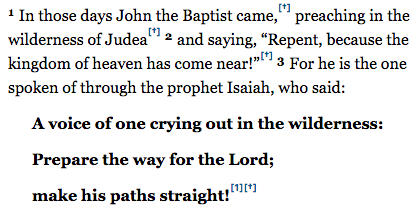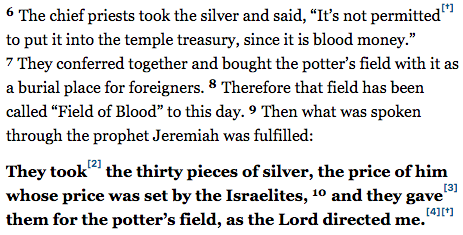Bible File Naming
Follow different text file naming conventions for Bibles.
For the main Bible content, do not use “chapter” in the file names. Instead, use the book OSIS and double- or triple-digit chapter number corresponding to the Bible chapter. There must be one text file for every Bible chapter.
For example, the name of the file containing the Genesis 1 in the New International Version would be named:
- NIV02_body0001_Gen01.xhtml
For the book of Psalms, use three digits in the file name for chapter numbers. For example, Psalm 22 in the Christian Standard Bible would be named: - CSB02_body0649_Ps022.xhtml
With front matter and back matter included, it would look something like: - CSB01_front01_cover.xhtml
- CSB01_front02_titlepage.xhtml
- CSB01_front03_copyright-page.xhtml
- etc.
- CSB02_body0001_Gen01.xhtml
- CSB02_body0002_Gen02.xhtml
- CSB02_body0003_Gen03.xhtml
- etc.
- CSB02_body1081_Rev22.xhtml
- CSB03_back01_appendix.xhtml
- CSB03_back02_appendix.xhtml
- etc.
Verse Numbers
It is traditional to surround verse numbers in our Bibles with a span.versenum
<span class="versenum">16</span> For God loved the world in this way: He gave his one and only Son, so that everyone who believes in him will not perish but have eternal life. |
mywsb.css contains attractive styling for the .versenum class
Bible Data Attributes
There are a few data attributes specific to Bibles which are required for Content Platform indexing.
Chapter Data Attributes
Each chapter requires a data-scripture-chapter attribute on the containing element (usually a <section>) with the value of the book and chapter:
<body epub:type="bodymatter"> |
Verse Data Attributes
Every verse requires a data-scripture-verse attribute on an element which contains the entire verse. The value must indicate the book, chapter, and verse.
Verse contained within one element
Sometimes a single verse is contained within one element, in which case, the data attribute can be put on the containing element:
<p data-scripture-verse="Gen.1.1"><span class="versenum">1</span> In the beginning God created the heavens and the earth.</p> |
Multiple verses in the same element
Other times, when there are multiple verses in an element, a <span> with the data attribute can be used to surround each verse:
<p><span data-scripture-verse="Gen.1.2"><span class="versenum">2</span> Now the earth was formless and empty, darkness covered the surface of the watery depths, and the Spirit of God was hovering over the surface of the waters.</span> <span data-scripture-verse="Gen.1.3"><span class="versenum">3</span> Then God said, “Let there be light,” and there was light.</span> <span data-scripture-verse="Gen.1.4"><span class="versenum">4</span> God saw that the light was good, and God separated the light from the darkness.</span> <span data-scripture-verse="Gen.1.5"><span class="versenum">5</span> God called the light “day,” and the darkness he called “night.” There was an evening, and there was a morning: one day.</span></p> |
Verse spans multiple elements
Another scenario sees a verse spanning multiple elements. I those cases, a <div> can be added with the data attribute to surround all elements of the verse:
<div class="di" data-scripture-verse="Ps.1.1"> |
The <div> should be styled as display: inline; in order to prevent its presence from changing the way the paragraphs are rendered. A .di class has been used here to accomplish this.
Verse begins or ends part-way through an element.
Where things get a little trickier is when a verse begins or ends part-way through an element, or both. In such cases, it will be necessary to add one or more <div>s, and change where elements start and stop. Additionally it will be necessary to change the CSS display styling of certain elements to preserve proper rendering, while still having each verse contained within its own element.
Verse ends part-way through an element
Notice in this example how verse 23 ends part-way into the next paragraph.

To accomplish this:
- divide the element containing the end of verse 23 at the beginning of the next verse.
- add a
display: inline;styled<div>around verse 23 - style the last element in verse 23 with
display: inline-block;(a.dibclass here) - style the first element of the next verse as
display: inline;(.diclass)
<div class="di" data-scripture-verse="Matt.1.23"> |
Verse begins part-way through an element
In this example, notice how verse 3 begins toward the end of the paragraph also containing verses 1 and 2.

To achieve this rendering:
- divide the element containing the beginning of verse 3 between it and verse 2
- style the element containing verses 1, 2, and the beginning of 3 to be
display: inline(.diclass) - add an empty
<p></p>before thedisplay: inlinestyled element in order to keep it from displaying inline with whatever comes before it. - add a
<div>withdisplay: inline;styling surrounding all of verse 3. - style the first element of verse 3 with
display: inline;to keep it visually in the same “paragraph” as verses 1 and 2
<p></p> |
Verse begins and ends part-way through elements
This final example shows the most complicated scenario. Notice how verse 9 begins toward the end of one paragraph, and ends in the middle of the next:

To get this to render properly:
- divide the element containing the beginning of verse 9 between it and the verse before, then give both elements
display: inline;styling - add an empty
<p></p>before the element containing verses prior to verse 9 - divide the element containing the ending of verse 9 between it and verse 10, and style both elements with
display: inline; - add an empty
<p></p>before the last element of verse 9 - add a
<div>withdisplay: inline;styling surrounding all of verse 9
<p></p> |